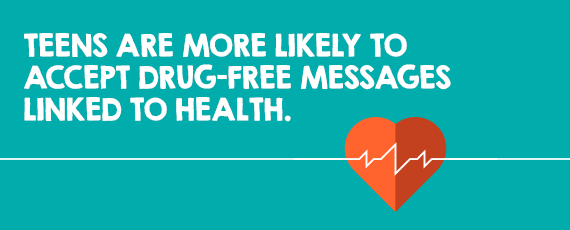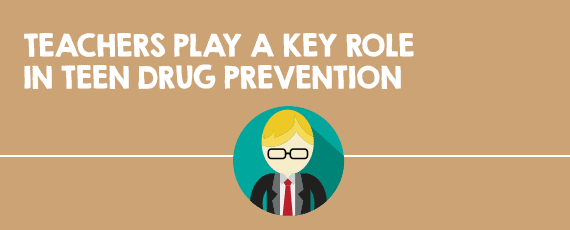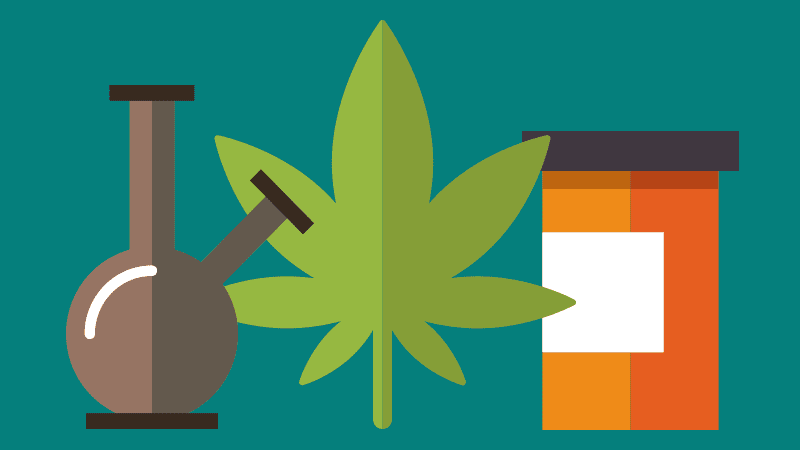High-school and middle-school teachers, hands up if you regularly talk to your students about the risks of drug and alcohol use. If you raised your hand, you might be surprised to know that you’re the exception! To be fair, it can be challenging to figure out how to talk to teens about drugs and alcohol in a way that won’t cause them to roll their eyes or tune out. And as teachers, it’s hard to know when it’s our place to intervene. Most drug and alcohol use happens off-campus, in that gray zone between parental and school responsibility. Too often we assume that parents are talking about drug prevention at home, and parents often assume that the school has the subject covered. As educators, we CAN play a critical role in helping kids stay drug- and alcohol-free. Research tells us to address this subject with our students early and often, and that some approaches are far more effective than others. Too many schools only talk about drug and alcohol use AFTER something tragic happens—after a car crash or a lost life. Prevention is everything. Here’s what you need to know:
-
Focus on health and brain science, not morality.
 In the past, education programs often focused on the legal or moral consequences of drug and alcohol use. “You’ll ruin your life,” they’d say, “and end up in jail.” Arguments that students perceive as hyperbolic or overly moralistic are more likely to be ignored, say public health experts. Instead, teach the science. Talking to teens about the lasting impact that drugs and alcohol can have on the body may be the most effective path to prevention. Robert Vincent, a public health analyst with the federal government’s Substance Abuse and Mental Health Services Administration’s (SAMHSA) Center for Substance Abuse Prevention, recommends talking explicitly about the connection between drugs, alcohol and learning.
In the past, education programs often focused on the legal or moral consequences of drug and alcohol use. “You’ll ruin your life,” they’d say, “and end up in jail.” Arguments that students perceive as hyperbolic or overly moralistic are more likely to be ignored, say public health experts. Instead, teach the science. Talking to teens about the lasting impact that drugs and alcohol can have on the body may be the most effective path to prevention. Robert Vincent, a public health analyst with the federal government’s Substance Abuse and Mental Health Services Administration’s (SAMHSA) Center for Substance Abuse Prevention, recommends talking explicitly about the connection between drugs, alcohol and learning.
Takeaway: Share this recent study that found that people who used marijuana frequently as teens had up to an eight-point drop in IQ even if they quit in adulthood. If teens hear that marijuana has been proven to decrease intelligence, they might just be a little less likely to experiment in the first place. -
It’s never too early to talk about prevention.

By age nine, kids are already building positive associations with drugs and alcohol, and some are starting to experiment, says Vincent of SAMHSA. Schools need to begin conversations with students by the fourth or fifth grade and continue those conversations throughout the rest of their educational journey. And that doesn’t just mean a once-a-year assembly. A “one and done” approach simply doesn’t work when it comes to drugs and alcohol.
Here’s why it matters: Research has shown that regular conversations about the dangers of drugs and alcohol can reduce the likelihood of teen use by as much as 42 percent (The National Center on Addiction and Substance Abuse [NCASA], 2011). Plus, teens who use drugs regularly are 65 percent more likely to develop an addiction than those who hold off using drugs until the age of 21, after which the chances of addiction drop to 2 percent.
Takeaway: Make a school-wide plan for conversations about drugs and alcohol. Aim to address it multiple times a year in different ways—for example, in homeroom, science or health class, during family nights or with an outside speaker. -
Today’s drug landscape is not the same as it was when you were a teen.

Today’s drugs are stronger, different and more easily accessible than ever before. The marijuana smoked today, for example, is up to three times more potent than the marijuana of 30 years ago. It can be damaging to long-term cognitive function and it can also be addictive.
The legalization of marijuana in some states has only added to the complexity. Yet, many teens don’t understand the risks. The national study Monitoring the Future,conducted by the University of Michigan, found just 32 percent of high school seniors believe regular marijuana use could be harmful, down from 36 percent a year ago.
ADVERTISEMENTAnother new concern is electronic cigarettes. While probably less harmful than tobacco cigarettes, e-cigarettes still pose a health risk. Recent surveys show most students who vape add flavoring to their e-cigarettes. The flavorings—such as strawberry, bubblegum and butterscotch—can lead users to perceive e-cigarettes as far more benign than they actually are.
Perhaps most troubling, prescription drug abuse and heroin use are on the rise. In 2012, 24 percent of teens surveyed said they had taken a prescription drug without a doctor’s prescription. With the tightening of prescription drug laws, and in light of the fact that heroin has a similar effect to opioid pain medications such as Oxycontin and Vicodin but at a fraction of the price, such use has increased, escalating some 53 percent between 2002 and 2013.
According to a 2014 study by SAMHSA, heroin use doubled in teens age 12 and older, increasing from a steady 0.1 percent during the years 2002 to 2013 to 0.2 percent in 2014. Fatal heroin overdoses between the ages of 15 and 24 increased more than 250 percent between 1999 and 2009, the latest year for which data is available from this source. And if heroin itself isn’t dangerous enough, the recent craze of lacing it with the powerful drug fentanyl—an anesthetic sometimes lethal even in small doses—has caused a wave of overdoses around the country.
Takeaway: When you talk to your students, don’t make assumptions based on your own teen experience. Because the drugs available today are more dangerous, even casual users are at risk.
-

Until age 25, the brain is essentially “under construction.” The limbic system, which controls emotional responses and impulses, develops at a faster rate than the prefrontal cortex, responsible for critical thinking and decision-making. For teens, this means that their brains are often relying more on impulse and emotions than rational decision-making, especially under stress or other influences.
“It’s harder for teens to make measured, thoughtful decisions,” says Elizabeth Davis, public health analyst with the National Institute on Drug Abuse in Rockville, Maryland. Their developing brains encourage them to engage in risks and new experiences, try out new identities, and exert their independence. This occurs at the very time their peers have a pronounced role in their lives, often more than that involving their parents. This can lead to poor choices.
Plus, drugs and alcohol can change the way the brain operates. When an individual uses an addictive substance, the system releases the feel-good chemical dopamine. After repeated use, the brain starts to adjust to surges in dopamine and the user builds up tolerance. The end result is that the ability to feel natural pleasure is reduced. Actual changes in the brain trigger an overwhelming need to use the substance again and again, and feeding this addiction becomes an overwhelming priority.
Takeaway: Talk with teens about brain science and development. Discuss ways that teens can get that dopamine release naturally—through exercise, spending time with friends, and doing things they love.
-
Drug and alcohol abuse does not discriminate.

Drug and alcohol abuse cannot be predicted by background, achievement level, family income, class or race. Sometimes, as teachers, we miss drug or alcohol problems in our students because we make assumptions, thinking “My honor roll student couldn’t possibly …” or “That student’s family would never let it happen.” It’s not that simple.
“Some of our ‘best’ kids are sometimes greatly affected … they are high-functioning, have greater resources, supportive parents and homes, and yet they still get into drugs and alcohol,” says Vincent. “Oftentimes the more affluent, the more problematic.”
Research has found that individuals are more likely to become addicted if they have a family history of addiction, if they start at a young age, or if they have other mental health problems. Still, the presence of risk factors doesn’t mean that someone WILL become addicted, notes Davis. Having a trusted adult to turn to can help a predisposed teen to steer clear of substance abuse problems.
Takeaway: Don’t dismiss worrisome signs because you feel like “drugs can’t happen here” or “not THAT student.” Keep an eye out for any of the symptoms listed below from any of your students.
-
Even if you think you know all the signs, you probably don’t.

While different substances can cause a range of disparate symptoms, there are a few key signs of drug and alcohol abuse that experts say we should watch for in the classroom:
- Decreased motivation
- Sudden shifts in mood
- Sleepiness in class or appearing tuned out
- Physical signs such as bloodshot eyes, unexplained weight loss or gain, deterioration of physical appearance or grooming
- Change in friend groups
- Paranoia or depression
- Uncharacteristic display of money or possessions (or the opposite—students looking to sell belongings, for example)
- Chronic absenteeism
- Abrupt drop-off in academic performance
Takeaway: If you see something, say something. Ask your students what’s going on. Talk to your students’ advisors or your school counselor. If you suspect an issue, let the student’s family know the behavior you are seeing, without speculation or accusation.
-
YOU can make a difference for your students.

“Be a good observer and don’t be afraid to share your concern,” says Neil Bernstein, a clinical psychologist in Bethesda, Maryland, and author of How to Keep Your Teenager Out of Trouble and What to Do if You Can’t. Your role as an educator is to inform, to listen when needed and to be a good role model.
At the same time, to say “no” to drugs, teens need things to say “yes” to as an alternative. Active discussion about healthy choices and positive after-school activities are key. “It’s about getting teens engaged in things that are important to them and allowing them to be cool without resorting to drugs,” says Davis.
The idea is to create a positive culture that allows teens to take risks and try on new identities within a safe space. Again, however, we can’t use a “one and done” approach. Teens face a barrage of influences every day, and prevention and education efforts need to be ongoing and engrained in school culture. It’s only through this ongoing, systematic approach that we can help our students stay drug- and alcohol-free.
Takeaway: Talk with fellow teachers, counselors, and administrators at your school. How can your school adopt a prevention strategy that touches all students, all school year long? Wherever, whenever you can, look for opportunities to nurture positive decision-making and healthy choices, whether it’s in the classroom, on campus or through extracurricular activities.

